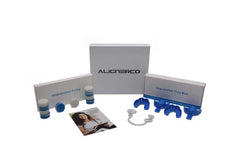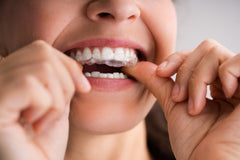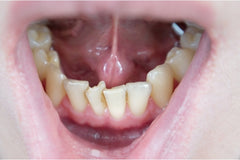A few years ago, if you needed orthodontic treatment, your only option for treatment was metal braces. However, this is no longer the case. Today, there are lots of more options for patients to choose from, including metal and ceramic braces, and clear aligners. This is great, especially for people who want to be able to personalize or be discreet about their braces. The differences can be confusing though. Are clear braces as good as the metal ones?
Conventional Braces vs Clear Aligners
The main aim of orthodontics is to correct teeth that are poorly position, in order to improve the bite function and the appearance of the smile. Orthodontics is often associated with children. It's true that often early on in childhood, interceptive orthodontics can help to create needed space and to facilitate the eruption of permanent teeth. However, many adults also need to undergo orthodontic treatment to realign the teeth permanently. The basic process of moving teeth is the same in adults and children, treatment can be done at any age. Some reasons for undergoing treatment include:
- To correct an overbite or teeth that are too high
- To realign teeth
- To correct space between the teeth or a dental overlap
- To prevent premature erosion
If you’re thinking about having your teeth straightened, it is usually a good idea, and not only for the reason of improving the appearance of your smile. Straightening also improves the way that your teeth and the jaw muscles function. If you do not correct a dental problem, it can lead to a lot of different complications:
-
- Increased number of cavities due to the difficulty of cleaning overlapping teeth
- Fractures in poorly positioned teeth
- Chronic inflammation of the gums
- Temporomandibular joint problems
There are two kinds of orthodontic treatments that can help; conventional braces and clear aligners.
Conventional Braces
Braces are the best-known orthodontic technique. However, braces have changed a lot in recent years, and many styles are now a lot more discreet than they used to be. Metal or porcelain brackets are bonded to the front of the teeth and are then interconnected by an archwire. The tightness of the wire can be varied, to gradually move the teeth according to a plan. This applies slight but steady pressure on the teeth to move them into a better position. The wire will need to replaced several times with a thicker wire to keep moving the teeth until the desired results are reached. After the braces have been fitted, they will need to be adjusted in order to keep the right degree of tension.
Clear Aligners
Clear aligners are a great solution for patients who need orthodontic treatment but want a more discreet option than more conventional braces, as they don’t use wires or brackets. Clear braces are a modern and almost invisible method for correcting mild to moderate orthodontic problems. Clear braces like this can align teeth just as well as braces do, but using a removable aligner. Adjustments appointments must be made, usually every six to eight weeks, the same as conventional braces. Clear aligners may be changed more often, based on the recommendations of your dentist. Every aligner adjusts your teeth according to the plan that your dentist decides on, by applying pressure to the teeth. One of the major advantages of clear aligners is speed. Usually, orthodontic treatment done with clear braces is faster than treatment with traditional braces. However, since patient compliance is essential to the success of the treatment, the patient must be disciplined about wearing the aligners all the time, or the treatment will take longer, and may not deliver the same results. For treatment with clear aligners, a virtual model of your teeth is created with a computer program, so all the steps can be planned, from the initial position of the teeth to the final result you’re hoping for. If you do choose to wear clear braces, you must take extra care to take care of your oral hygiene. Clear aligners are removed to brush your teeth and floss, so you must make sure you do a thorough job.
Advantages Of Clear Aligners
The main advantage of clear braces is that they’re invisible. You won’t have to wear an uncomfortable mouthful of clunky metal wires and brackets. For teenagers, one of the big worries of wearing braces is being teased and not fitting in with their peers. Many worries that metal braces will prevent them from fitting in. Braces can make them feel anxious and upset. Having to wear braces for more than a year is unlikely to do much for the self-confidence of a teenager at a time of life when they feel vulnerable and unsure already. Clear aligners are an ideal solution to this problem, as they are far more discreet. For many adults, the appearance of the smiles can be just as important as it is for teenagers. If you work in a highly visible occupation, such as sales or marketing, you might worry about making a good impression on any new contacts, and your appearance plays a part in that. If you are in a high-powered position, you may also worry that metal braces make you look younger, and therefore underqualified to be in a management role. A smile shows other people that you’re trustworthy, friendly, and approachable, which are all critical factors in the business world. No matter what job you have, a professional appearance with a big, friendly smile can go a long way toward making a good impression and helping to make relationships and seem more confident. If you have to wear metal braces, you might not feel like smiling as often. Metal braces can get in the wary of making you seem professional at work. Clear braces mean you retain your smile and your confidence when you are having orthodontic work done. Another advantage of clear aligners is that they’re removable, which makes it easier to look after. You can just pop the aligners out and store them in a small carrying case when you want to eat. Aligners let you carry on eating any food that you like, which can be harder with metal braces. Having to give up foods you love is tough, so being able to remove the aligners to eat is very useful. With braces, you can’t eat chewy or rubbery foods, foods that stick to the teeth, brittle foods, or harder vegetables, which can be really limiting. Metal braces can also be a problem for being intimate. When kissing your partner, they will be able to feel metal braces. Teenagers have even been known to get interlocked! Clear aligners are much more pleasant to wear when kissing, or you can just remove them. Because clear aligners can be easily removed, it’s much easier to care for your teeth than it is when wearing metal braces. You can remove them, and take care of your teeth with your usual brushing and flossing routine. Metal braces can be less hygienic, as the wires and brackets can trap food between the teeth. This can happen with clear aligners too, so you must remember to check them carefully. When wearing traditional braces, you can damage your tooth enamel if you don’t take care of your teeth properly.
What Conditions Can Be Treated With Clear Aligners?
Clear aligners are custom built in order to give a tight fit, they’re best for
adults or teens. Straightening the teeth of a child is a more complicated process. In young people, their mouths are still growing and developing, so there is more to think about when deciding on the best plan of treatment. Clear aligners are usually the best option for patients who only have mild or moderately
crowded teeth, or have minor spacing issues. For those who have severe crowding or spacing problems, severe underbites, severe overbites, or crossbite, more complex treatment is often needed.
How Long Do Clear Braces Take?
Treatment time with clear aligners is based on how much your teeth need to move or rotate. The more changes you need to your bite or the more crooked your teeth are, the longer the treatment will take. On average, the treatment can take between 10 and 24 months. If you’re now an adult, but wore braces as a child, and your teeth have shifted back a bit over the years, clear aligners can be used to correct this, and could take effect in as little as 10 weeks. Invisible aligners are not quite as precise as more traditional metal braces, so some patients may need a refinement of their teeth using braces for a few months to make other, small adjustments when their treatment with the clear braces has been completed. Using the two options in combination like this could really help you to achieve your perfect smile. The price of invisible aligners can vary from dentist to dentist, but may often be cheaper than the metal options, so can end up saving you a lot of money.
Do Clear Aligners Hurt?
Having mild pain or sore teeth while wearing your clear aligners for treatment is totally normal. Metal braces, however, are much more painful and uncomfortable, as they tend to do more extreme movement of the teeth, and have the added disadvantage of bulky metal in the mouth. Mild pain with clear aligners is usually much more manageable. The best way to think about pain from clear braces is to compare it to how you feel after a good workout at the gym. You might feel a bit sore, but you know that it’s a good thing because it means your muscles are working hard. The same is true of your teeth. Some soreness or mild pain is a good sign that your aligners are working and doing what they’re supposed to be doing to improve your bite and your smile. The soreness is because the aligners are gently moving your teeth into a beautiful new smile. A lot of people worry about the pain involved with braces or clear aligners. It is totally normal to feel some pain when you’re wearing aligners, but this pain is usually less severe than the pain from metal braces, especially as you will be able to avoid the infamously very painful adjustments of metal braces. Not everyone feels soreness or pain during the process of having their teeth straightened, and this is a normal reaction too. If you do, experience pain, there are useful tricks to manage discomfort at home, so you can live pain-free while you wait for your new smile. Clear aligners are usually much more comfortable to wear as well. Metal braces can rub the inside of your lips and cheeks when you first have them fitted, whereas clear aligners are carefully designed to be smooth and comfortable to wear, with no rubbing. When you first start to wear a new clear aligner, it is normal for it to feel a bit tight, but this is nothing to worry about. The tightness is just the pressure of the aligner gently moving your teeth. If you’re considering clear aligners, it’s wise to speak to your dentist first. They can advise you of the problem that you want to correct is suitable to be treated with clear aligners, or whether you ought to wear metal braces. Clear aligners can be cheaper, more comfortable, more hygienic, and are much more discreet to wear, so they can be a much better option for lots of people. Whether you’re worried that your teenager will struggle with the pain and discomfort of metal braces, or you want to straighten your own smile, but don't want to reveal a mouth full of metal when you smile when you’re leading a board meeting, then clear aligners are the best choice. To discuss your options, call ALIGNERCO on
+1 (647) 366-5990 or email on
team@alignerco.ca. Our team is on hand to answer all your questions and help you decide if clear braces are the best choice for you, and clear any concerns that you may have.



















